 My colleague Sam Millette, senior investment research analyst on Commonwealth’s Investment Management and Research team, has helped me put together this month’s Market Risk Update. Thanks for the assist, Sam!
My colleague Sam Millette, senior investment research analyst on Commonwealth’s Investment Management and Research team, has helped me put together this month’s Market Risk Update. Thanks for the assist, Sam!
Markets continued to rise in June, as efforts to reopen state economies across the country continued throughout the month. Investors reacted to the continued reopening with optimism, driving the S&P 500 up 1.99 percent in June following a 4.76 percent increase in May. These positive results came despite some midmonth volatility created by concerns of rising national coronavirus case numbers. While the continued market rebound during the month was certainly welcome for investors, very real risks to markets still remain—and there are several key factors that matter when determining the overall risk level.
Recession risk
Recessions are strongly associated with market drawdowns. Indeed, 8 of 10 bear markets have occurred during recessions. As we discussed in this month’s Economic Risk Factor Update, the National Bureau of Economic Research (NBER) declared that a recession started in February. On top of that, most of the major economic indicators that we cover monthly remain at a red light, despite some better-than-expected results during the month. As such, we have kept the economic factors at a red light for July.
Economic shock risk
There are two major systemic factors—the price of oil and the price of money (better known as interest rates)—that drive the economy and the financial markets, and they have a proven ability to derail them. Both have been causal factors in previous bear markets and warrant close attention.
The price of oil. Typically, oil prices cause disruption when they spike. This is a warning sign of both a recession and a bear market. In this case, however, the sudden drop is also a warning of significant disruption.

The price of oil continued to decline notably on a year-over-year basis in June, falling by 29.9 percent compared with last June. On a month-to-month basis, however, prices increased from an average of $28.55 per barrel in May to $38.32 per barrel in June. This increase brought the average price of oil to its highest monthly level since February, indicating that the sharp drop in prices in April was likely the low-water mark for oil prices in the short term.
Going forward, sustained oil prices at these levels continue to signal a risk, with the energy industry being massively disrupted, as we saw back in 2015. With that being said, the continued recovery in prices in June is a positive development for energy companies, and prices still remain low enough to be a boon for consumers. With reopening efforts taking hold in June, gasoline demand rose notably during the month; however, demand still sits below historically normal levels.
Despite the positive tailwind that low prices create for consumers, we’ve left this indicator at a red light for now given the disruption to the energy sector caused by the large year-over-year decline in prices. A potential upgrade to yellow is possible if we continue to see modest price recovery in July.
Signal: Red light
The price of money. We cover interest rates in the economic update, but they warrant a look here as well.
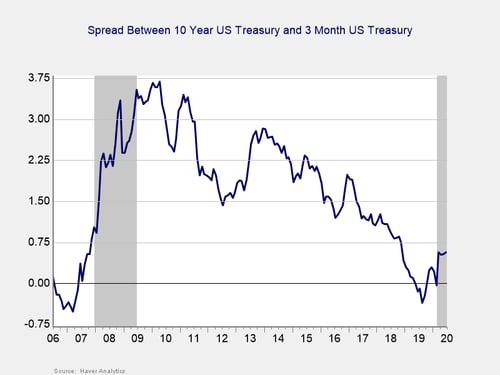
After spending the fourth quarter un-inverted, the yield curve re-inverted in January, remained inverted throughout February, and un-inverted again in March, where it has remained throughout the pandemic. This un-inversion was driven by a sharp drop in short-term rates, which in turn was caused by the Fed’s decision to cut the federal funds rate to effectively zero percent in March. The yield on the 3-month Treasury remained largely range bound in June, rising modestly from 0.14 percent at the end of May to 0.16 percent at the end of June. The 10-year yield also increased modestly during the month, up from 0.65 percent to 0.66 percent.
While an inversion is a good signal of a pending recession, it is when the gap subsequently approaches 75 bps or more that a recession is likely. We finished June with a spread of 52 bps, and the NBER declared a recession started in February. In light of that, and with the spread remaining near the critical level, we are leaving this indicator at a red light.
Signal: Red light
Market risk
Beyond the economy, we can also learn quite a bit by examining the market itself. For our purposes, two things are important:
- To recognize what factors signal high risk
- To try to determine when those factors signal that risk has become an immediate, rather than theoretical, concern
Risk factor #1: Valuation levels. When it comes to assessing valuations, we find longer-term metrics—particularly the cyclically adjusted Shiller P/E ratio, which looks at average earnings over the past 10 years—to be the most useful in determining overall risk.
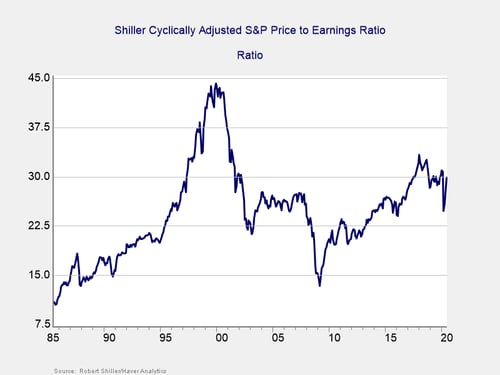
Valuations increased for the third month in a row in June, from 27.34 in May to 29.96 in June. This follows a steep drop to a three-year low of 24.9 in March, at the height of the recent pandemic-driven volatility. Despite the fact that valuations remain below recent highs, risks still remain given the relatively high valuation from a historical perspective.
Even as the Shiller P/E ratio is a good risk indicator, however, it is a terrible timing indicator. To get a better sense of immediate risk, we can turn to the 10-month change in valuations. Looking at changes, rather than absolute levels, gives a sense of the immediate risk level, as turning points often coincide with changes in market trends.

Here, you can see that when valuations roll over, with the change dropping below zero over a 10-month or 200-day period, the market itself typically drops shortly thereafter. This relationship held in March, as valuations and the index both rolled over during the month before partially rebounding. June saw valuations increase on a rolling 10-month basis for the first time since the crisis began. Given the continued rebound in valuations and markets during the month, we’ve kept this signal at a yellow light for now.
Signal: Yellow light
Risk factor #2: Margin debt. Another indicator of potential trouble is margin debt.
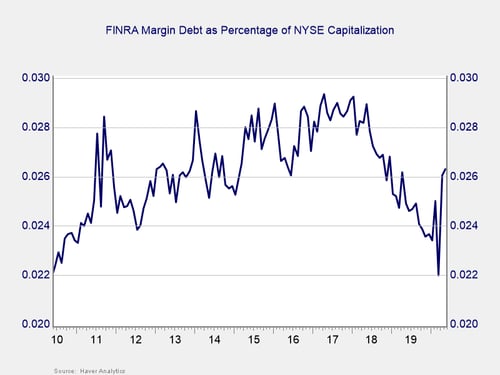
Debt levels as a percentage of market capitalization had dropped substantially over the past two years, to close to the lowest levels of the recovery, before spiking in February to a 6-month high. March saw this measure of market debt fall to levels last seen in 2010, as investors de-risked, before rebounding in April and May along with the market. With the rebound, margin debt remains high on a historical level but at levels consistent with those of recent years.
For immediate risk, changes in margin debt over a longer period are a better indicator than the level of that debt. Consistent with this, if we look at the change over time, spikes in debt levels typically precede a drawdown.
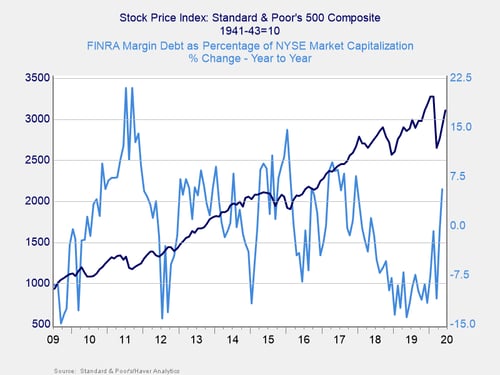
As you can see in the chart above, the annual change in debt as a percentage of market capitalization increased notably in February, before falling steeply in March and rebounding in April and May.
The rebound in May’s debt levels indicates that risk remains, as debt increased by 5.6 percent on a year-over-year basis during the month. This marks the highest year-over-year increase since December 2017. Given the increase in debt on both a monthly and year-over-year basis, and the fact that the overall debt level remains historically high, this is worth monitoring. So, we are keeping this indicator at a red light.
Signal: Red light
Risk factor #3: Technical factors. A good way to track overall market trends is to review the current level versus recent performance. Two metrics we follow are the 200- and 400-day moving averages. We start to pay attention when a market breaks through its 200-day average, and a break through the 400-day often signals further trouble ahead.
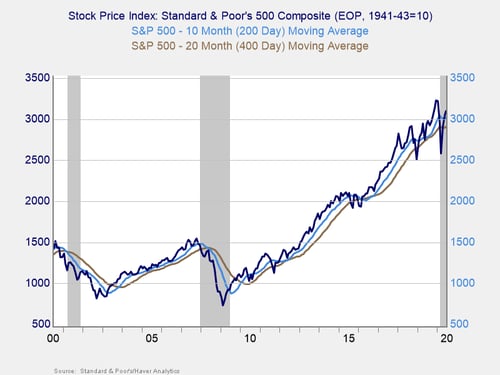
Technical factors were mixed again in June. The S&P 500, which managed to break above its 200-day moving average at the end of May, finished above trend for the second month in a row, despite briefly falling below this important technical level twice during the month. The Dow Jones Industrial Average, on the other hand, broke above trend briefly early on in the month before falling back and finishing June below its 200-day moving average. The Nasdaq was the only major index that spent the entire month above its 200-day trend line, after doing the same in May.
The 200-day trend line is an important technical signal that is widely followed by market participants, as prolonged breaks below this trend line could indicate a longer-term shift in investor sentiment for an index. The 400-day trend line is also a reliable indicator of a change in trend. As we saw in June, the S&P 500 was able to spend much of the month above its 200-day moving average, after passing the 400-day in April. This is an encouraging signal that has continued into July; therefore, we have kept this signal at a yellow light for the month.
Signal: Yellow light
Conclusion: Market risks remain despite rebound
Economic fundamentals showed rapid improvement in June, and markets continued to react largely positively, despite some volatility driven by concerns of rising infections counts. Given the faster-than-expected pace of economic recovery since reopening efforts began, the economy appears to be on the right track for a swift rebound for the time being. With that being said, the country is still not out of the woods yet in terms of either containing the virus or fully normalizing the economy, which is what markets are now pricing in—leaving them exposed to any setbacks.
Setbacks remain likely, whether in the form of rising case counts that lead to a slowdown or even rollback of reopening efforts, or political factors such as the current social unrest or pending election. Given the multiple red light indicators, such setbacks could easily result in more volatility.
As such, we are keeping the overall market risk indicator at a red light. This is not a sign that markets are necessarily headed back to the lows. Instead, it is a recognition that the path back to normal is likely going to be a long road with the potential for setbacks that could lead to additional market pullbacks. Given the uncertainty created by the pandemic and the likelihood for further volatility, investors should remain cautious on equity markets despite recent outperformance.



 Print
Print

